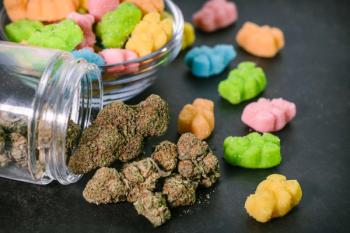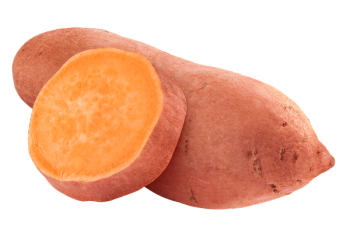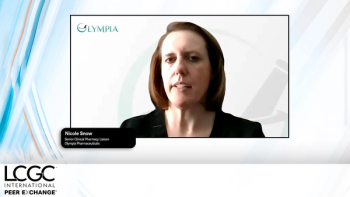
Monitoring Microcontaminants
LCGC spoke to Ana Mar?a Garc?a Campa?a about the issues and the development of techniques associated with monitoring veterinary drug residues in foods for human consumption.
LCGC spoke to Ana María García Campaña about the issues and the development of techniques associated with monitoring veterinary drug residues in foods for human consumption.
What techniques are generally used in the monitoring of veterinary drugs in food for human consumption?
Animals for food have to be treated with medicines (antibiotics, anthelmintics, glucocorticosteroids, antiprotozoals, tranquilizing agents, or beta-blockers) to prevent or cure disease, but these substances can leave residues in the food products from the animals which could be harmful for consumers so analytical methods must be available for their monitoring. Liquid chromatography (LC) is the most widely used technique, and is used mainly in combination with tandem mass spectrometry (MS–MS) to achieve the unequivocal identification of veterinary drug residues in food (1).
Among the different analysers available for MS, triple quadrupole operating in multiple reaction monitoring (MRM) mode is one of the most widely used because of its suitability for quantification of target compounds. Also, as a result of the column technology evolution with the introduction of sub-2 µm particle sizes, ultra-high pressure chromatography (UHPLC) has been rapidly adopted, improving efficiency, resolution, and sensitivity, as well as significantly reducing sample analysis time and mobile phase solvent consumption. In this case it is necessary to apply higher pressures (10,000–15,000 psi) using specific instruments.
An interesting option that does not require special pumps is the use of analytical columns with core–shell technology. These columns are packed with 2.6-µm core–shell particles which consist of a solid core (1.9 µm) and a porous shell. As a result, shorter diffusion paths are obtained, therefore allowing high efficiency even at high flow rates. They are available with different natures (phenyl-hexyl, C18, C8, pentafluorophenyl [PFP], and hydrophilic interaction chromatography [HILIC]) and have also been used for the monitoring of veterinary drugs.
Moreover, during the last decade, miniaturized techniques have been applied, such as capillary electrophoresis (CE) or capillary high-performance liquid chromatography (capillary HPLC). Two different CE modes are used in the control of veterinary drugs, capillary zone electrophoresis (CZE) and micellar electrokinetic capillary chromatography (MEKC). Some applications have been developed using capillary HPLC in this field but so far the variety in the nature of the stationary phases is still very limited.
In relation to sample treatment (2), liquid-liquid extraction, liquid-solid extraction, and solid-phase extraction (SPE) for preconcentration and cleanup have traditionally been the methods of choice in the determination of veterinary drugs in foodstuffs of animal origin. In addition, microwave-assisted extraction (MAE), ultrasound assisted extraction (UAE), and pressurized liquid extraction (PLE) have been efficiently applied for solid samples. However, in recent years significant progress has been made in increasing efficiency in the extraction and cleanup, introducing new sorbents (molecularly imprinted polymers [MIPs], restricted access materials [RAMs], and nanomaterials), automated processes coupling on-line sample preparation, or developing greener methods which imply solvent reduction or use of less toxic reagents.
What are the benefits of using miniaturized techniques in the detection of veterinary residues?
CE presents suitability for automation, high sample throughput, and multiple detection modes, but it also demonstrates additional advantages such as high efficiency, large flexibility, and low consumption of samples and reagents, similar to capillary HPLC. Both techniques could be classified as green analytical strategies, because of the reduction of contaminant wastes and organic solvents. Indeed, in CE there is no need of organic solvents at all since buffers are used as separation media.
Another important trend in the monitoring of veterinary residues in foods is the development of microextraction techniques (3), environmentally friendly because of the reduction of the amount of solvents required to just a few microlitres (such as matrix solid-phase dispersion [MSPD] and liquid-phase microextraction [LPME]) and the reagent toxicity (that is, using ionic liquids [IL]). Among these sample treatments, dispersive liquid-liquid microextraction (DLLME) is a suitable alternative that has been successfully applied to determine different compounds, mainly pesticides in water samples, and can be successfully combined with some separation techniques, such as gas chromatography (GC) or HPLC. Recently, some applications have been developed in the detection of veterinary residues as contaminants in environmental water samples.
CE has also been used as a separation technique, and could be considered as a green alternative, combining the advantages of DLLME with the low consumption of reagents and samples and the high preconcentration factor achieved and the low environmental impact of the waste generated. In addition, other reduced-solvent techniques, such as solid-phase micro extraction (SPME) and stir-bar sorptive extraction (SBSE), are suitable for liquid samples. Finally, CE in chip format has also attracted interest in recent years and there are several studies employing chip-based microfluidic systems for the determination of veterinary drugs (4).
How easy is it to develop new strategies using miniaturized analytical techniques?
This is not an easy task because we live in a macro world and to use miniaturized techniques we have to develop an interface to transfer the macro problem to the micro instrumentation. The development of such an interface is one of the main challenges for scientists working in this field but it is not the only one that has to be tackled. For example, in the monitoring of antibacterial residues in foods, where maximum residue limits (MRLs) are established, high sensitivity is required.
This could be an analytical limitation for the establishment of a miniaturized method, for example, of CE, when considering the narrow bore of CE capillaries that limit the injection volume to nanolitres and the fact that detection is performed on-capillary, most often by UV–vis, with shorter optical detection path lengths than in HPLC. Different strategies have been proposed to overcome these drawbacks, such as the application of optimized sample injection techniques to introduce higher volumes of sample. By stacking, it is possible to transform a long sample zone into a short one, therefore gaining an increase in its concentration and ultimately detection sensitivity (5).
In addition, the coupling of CE with SPE improves sensitivity in the monitoring of these residues. Different combinations can be found: off-line SPE–CE, which has no integration and the sample is manually transferred from the SPE column to the CE system; at-line coupling, an automated off-line combination that uses a robotic device to prepare the sample and an auto-injector to inject the extract into the CE instrument. There is no direct stream of liquid between the SPE unit and the analytical unit and the whole extract is not transferred to the CE instrument; in-line SPE–CE, which entails complete integration between SPE and CE, normally involving the insertion of the SPE material into the capillary where the electrophoretic separation takes place; and on-line coupling, which comprises physical connection and contact between the capillary and the stream flowing from the SPE column. This coupling is performed using an interface that automatically transfers the analytes from the SPE column to the separation capillary.
Other approaches to increase detection limits in capillary techniques (CE or capillary HPLC) are the use of more sensitive detection techniques such as laser-induced fluorescence (LIF) and CE–MS, an attractive alternative to HPLC–MS in food analysis, which combines the advantages of both techniques and is increasingly being used in the determination of drugs.
After the recent coverage of veterinary residues in the food chain (mainly antibiotics), is there more awareness of the issue in general?
I think so. In the last few years, the concern about the use of veterinary drugs in food-producing animals and their possible negative effects in the health of consumers has made the control of these residues in edible animal tissues mandatory at the EU. Initially, the EU Directive (96/23/CE) established the control measures and the alert plans to be applied for the detection of special substances and their residues – potentially toxic for the consumer – in live animals or products of animal origin used in human consumption.
MRLs of antibiotics in foodstuffs of animal origin such as multiple animal tissues (for example, muscle, liver, kidney, or fat), milk, or eggs were established and have recently been revised by the Commission Regulation (EU) No 37/2010 for safe consumption. Moreover, technical guidelines and performance characteristics, such as detection level, selectivity, and specificity for residue control are described in the Commission Decision 2002/657/EC, including additional requirements for confirmatory methods by introducing the concept of identification points (IPs) to achieve unambiguous identification of the monitored legislated residues.
Specifically in the case of the antibiotics, the concern about their residues in foods derived from animals and the misuse in humans has increased as a result of the transfer of antibiotic-resistant bacteria to man and their illegal use as growth promoters. In this sense, the EU has promoted the European Antibiotic Awareness Day, every 18 November, an annual European public health initiative to raise awareness about the threat to public health of antibiotic resistance and to promote prudent antibiotic use.
On the other hand, veterinary drugs together with personal care products and pharmaceutical substances, including antibiotics, have experienced a growing interest as emerging pollutants and a lot of recent studies have shown that a multitude of drugs are present in aquatic systems, which suggests negative effects for ecosystems (6).
Currently, the evolution in the field of veterinary residues in foods, and in the monitoring of contaminants, is based on the development of multianalyte methods to determine a variety of compounds of different families in a single analysis. In addition, the analysis of metabolites and degradation products of food contaminants, especially those that are considered genotoxic or carcinogenic, is of great interest. So, in order to monitor targeted and untargeted compounds, recent papers have been published using accurate mass full-scan MS techniques (time-of-flight mass spectrometry [TOF-MS], Orbitrap).
Moreover, generic sample preparation procedures are necessary to simultaneously extract different types of compounds from different matrices, this is the so-called extraction or “dilute-and-shoot” type methods. In this sense, QuEChERS (Quick, Easy, Cheap, Effective, Rugged, and Safe) has recently become an interesting alternative to the analysis of veterinary drug residues in food matrices, simplifying and reducing the time of extraction and cleanup.
How did you become interested in this work?
In our group we have always worked with analytical issues related to food quality, environmental contamination, and clinical and forensic analytical chemistry. We started working with veterinary residues in animal products intended for human consumption and were conscious of the fact that these residues may be directly toxic or even cause allergic reactions and in several countries legislation had been established for their control. Therefore, because of the low concentrations allowed (and in some cases they are absolutely forbidden), sensitive and efficient analytical methods were needed.
We initially proposed the use of CE, which had not been so well explored in this field, as an alternative to the well-established methods in LC and in this sense we have been working with different families of veterinary drugs [quinolones (7), sulfonamides (8 ), penicillins (9 ), cephalosporins (10) nitroimidazoles (11)], using CE coupled with UV–vis, LIF, or MS detection. We developed different on-line (9,10) and in-line preconcentration strategies (7,8) to increase sensitivity (stacking techniques, in-line SPE), and were able to obtain limits of detection below the MRLs.
We have also used capillary HPLC (12,13) with UV–vis or LIF detection, combining both analytical techniques (CE and capillary HPLC) with different sample treatments following green chemistry trends related to the generic sample procedures, or with the use of new materials (MISPE, DLLME, IL-DLLME, hollow-fibre microextraction, PLE, UASEME, or QuEChERS), and obtaining satisfactory precision and trueness for the analysis of different foods (animal tissues, muscle, milk, kidney, liver, eggs, or honey) in which the maximum content is regulated. Recently, we have begun developing new UHPLC–MS and UHPLC–FL methods for multianalyte determination of veterinary drugs and pesticides in a great variety of food and environmental matrices (14) in addition to exploring an interesting area on natural contaminants in foods, the mycotoxin analysis (15).
References
1. B.J.A. Berendsen, L.A.M. Stolker, and M.W.F. Nielen,
TrAC- Trends Anal. Chem.
43
, 229–239 (2013). 2. M.D. Marazuela and S. Bogialli,
Anal. Chim. Acta
645
, 5–17 (2009).
3. M. Asensio-Ramos, L.M. Ravelo-Pérez, M.A. González-Curbelo, and J. Hernández-Borges, J. Chromatogr. A1218, 7415–7437 (2011).
4. Y. Ding, L. Bai, X. Suo, and X. Meng, Electrophoresis33, 3245–3253 (2012).
5. M.C. Breadmore, A.I. Shallan, H.R. Rabanes, D. Gstoettenmayr, A.S. Abdul Keyon, A. Gaspar, M. Dawod, and J.P. Quirino,
Electrophoresis
34
, 29–54 (2013). 6. J.M. Brausch and G.M. Rand,
Chemosphere
82
, 1518–1532 (2011).
7. F.J. Lara, A.M. García-Campaña, F. Alés-Barrero, and J.M. Bosque-Sendra, Electrophoresis29, 2117–2125 (2008).
8. F.J. Lara, A.M. García-Campaña, C. Neusüβ, and F. Alés-Barrero, J. Chromatogr. A1216, 3372–3379 (2009).
9. M.I. Bailón-Pérez, A.M. García-Campaña, M. del Olmo-Iruela, C. Cruces-Blanco, and L. Gámiz-Gracia,
Electrophoresis
30
, 1708–1717 (2009). 10. C. Quesada-Molina, M. del Olmo-Iruela, and A.M. García-Campaña,
Anal. Methods
4
, 2341–2347 (2012). 11. M. Hernández-Mesa, C. Cruces-Blanco, and A.M. García-Campaña,
Anal. Bioanal. Chem.
404
, 297–305 (2012). 12. M. Lombardo-Agüí, L. Gámiz-Gracia, C. Cruces-Blanco, and A.M. García-Campaña,
J. Chromatogr. A
1218
, 4966–4971 (2011). 13. C. Quesada-Molina, M. del Olmo-Iruela, and A.M. García-Campaña,
Talanta
in press (2013). 14. M. Lombardo-Agüí, A.M. García-Campaña, L. Gámiz-Gracia, and C. Cruces-Blanco,
Talanta
93
, 193–199 (2012). 15. N. Arroyo-Manzanares, J.F. Huertas-Pérez, L. Gámiz-Gracia, and A.M. García-Campaña,
Talanta
115
, 61–67 (2013).
Ana María García-Campaña graduated in 1989 and received her PhD in 1995 in chemistry from the University of Granada, Spain. She has been an associate professor in the Department of Analytical Chemistry at the University of Granada, Spain, from 1990 to 2010, and in 2010 she became a full professor. In 2002 she organized, together with her group, the “X International Symposium on Luminescence Spectrometry” and in 2007, the “VII Scientific Meeting of the Spanish Society of Chromatography and Related Techniques”, both held in Granada, Spain. She is responsible for the research group “Quality in Clinical, Environmental and Food Analytical Chemistry”. The main lines of research are related to food quality and safety, environmental, forensic, and biomedical analysis. In the food control area, new approaches have been developed for the assessment of contaminated waters, soil, and vegetables by pesticide residues or drugs. Other research lines are focused on the determination of veterinary drug residues in foodstuffs of animal origin, and also in the monitoring of mycotoxins in different foods and beverages. The main aim of the group is the establishment of multianalyte methods to determine these microcontaminants in foods with regards to sensitivity, reduction of analysis time, miniaturization, semi-automation, assurance in the identification and confirmation of the analytes, and, in general, an adequate validation according to the criteria of “fit-for-purpose”. They also focus on the necessities of public and private food quality control laboratories for progressing in analysis methods of hazardous chemical agents with the aim of increasing sample processing, reducing analysis time, cost, and environmental risk.
Related content:
Newsletter
Join the global community of analytical scientists who trust LCGC for insights on the latest techniques, trends, and expert solutions in chromatography.





